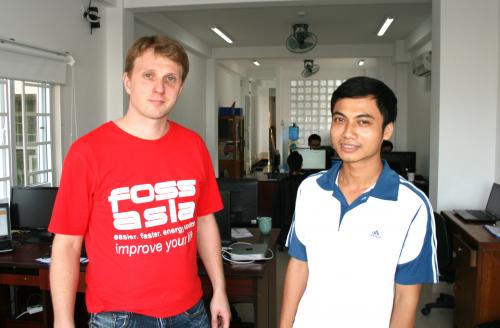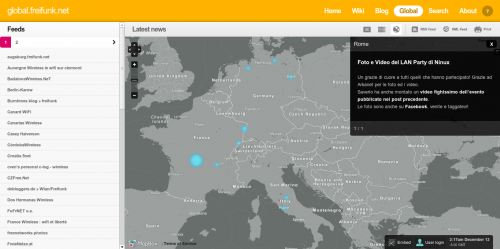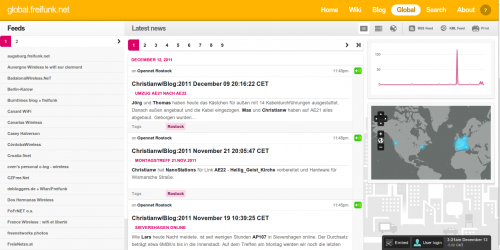


Das Community Blog




L-VN is a tool for overlay network creation based on IP in UDP encapsulation performed in Kernel space without encryption/authentication of the tunneled packets. The idea of L-VN is to exploit the IP/UDP encapsulation kernel module proposed for GSoC 2010 to develop a VPN/Overlay tool based on IP/UDP encapsulation performed in kernel space with no “security services” for the encapsulated packets (i.e. no confidentiality, no authentication). The goal is to provide a lightweight overlay network tool that might be preferable to other VPN/Overlay solutions for devices with limited computational resources. The project is a Freifunk-Ninux.org proposal, and is sponsored by the Google Summer of Code 2011 program.
L-VN consists of 3 main elements:
The code is available through the ninux SVN repository, at the path: https://svn.ninux.org/svn/ninuxdeveloping/ipudp/v02. Comments, remarks or any kind of support will be truly appreciated.
Contacts: marco.bonola@uniroma2.it, marco.giuntini@uniroma2.it
This article appeared first on Ninux.org:
http://blog.ninux.org/2011/09/05/gsoc-2011-l-vn-lite-virtual-network/
Do wireless communities around the world really need another map server? Here in Ninux we believe that the answer is yes!
Enter Nodeshot an open source wireless community map server written in python and based on django, focused on ease of useand performance.
Why a new map server? Mainly because we had some precise needs that the current open source map servers can’t satisfy easily:
The frontend is built in HTML5 and it does an intensive use of jQuery and the Google Map API.
The backend is based on the django admin and it permits to easily administer the app.
These are the main features of the nodeshot:
During the development we used github to commit changes and several merges have occurred in some cases when different developers were working to fix some issues.
The project has revealed to be more complex than what was expected but at the same time has been really engaging and fun.
There is still work to do though, actually we are translating and optimizing the app. We’ll keep working on nodeshot so that we can arrive quickly to a stable and performant release, we hope we’ll attract new developers from all around the world that will help us to push forward this new open source project!
Meanwhile, you can check the demo and you can download the source code on github.
This article appeared first on the website of Ninux.org:
http://blog.ninux.org/2011/09/06/gsoc-2011-nodeshot
I’m writing about the results achieved with my Google Summer of Code project, for the Ninux community, under the umbrella of Freifunk (I thank them both for the opportunity they gave me).
Briefly it consisted in developing a video chat feature for Diaspora*, a distributed social network.
This project has received a very big feedback and appreciations from the entire Diaspora community, including the core team, who helped and supported me during the development.
Basically, it provides two new functionalities to the Diaspora engine:
Source code can be found at https://github.com/vcuculo/diaspora, under “jabber” and “video_chat” branches.
Setup instructions here. Some screen-shots: [1], [2], [3].
I hope it will be soon merged and improved by me and the community, to make it available on every Diaspora* pod!
Vittorio
**This article appeared first on the website of Ninux, our friends from Italy: http://blog.ninux.org/2011/08/30/gsoc-2011-videochat-for-diaspora/
The Ninux community, under the umbrella of Freifunk, developed four awesome open-source projects for the Google Summer of Code program 2011: a front-end for RadioMate, a new mapserver (called nodeshot), a video and chat extension to the social networking engine Diaspora* and a new tunneling tool.
In this post I will write about RadioMate, the project I was involved in. Then posts on the other projects will follow!
There are many web-radio projects that are closely involved in the world of Community Networks: in Rome Fusoradio and Radio Sonarare an active part of the community and relay on the ninux network for their streaming, in Leipzig Radio Blau (which transmits also in FM) gives big spaces to the Freifunk project, or RadioCona in Ljubljana, where the Wlan Slovenija project is based.
Often these web radios have to relay on closed-source software platforms as the available open-source solutions don’t fit their needs.
RadioMate is a free (as in freedom) community-wise Web-radio management system. Some of its features are:
While last year the RadioMate engine was developed, this year our efforts focused on a Web frontend. You can find a demo atradiomate.ninux.org. The username is “foobar” while the password is “secret”. Point also your player (e.g. VLC) atradiomate.ninux.org:8000.
For the techies, the engine is based on liquidsoap, written in Python, and easily extendable through liquidsoap scripts. It exports a JSON API which is exploited by the Javascript (jQuery) based Web frontend. Source code and documentation can be found at radiomate.org.
Of course there is still work to do, but I hope that this software will be soon used by our friends running webradios!
As we say in Rome:Daje!
Clauz
This article appeared first on the website of Ninux.org:
http://blog.ninux.org/2011/08/29/gsoc-2011-radiomate/
Starting Friday June 3 till Sunday June 5, 2011 freifunk.net, c-base and the German community invite you to the “Freifunk Wireless Community Weekend” at the c-base space station in Berlin.
all the ad-hoc workshops will take place in the seminar room
mainhall hackcenter (Irgendwo an einem Tisch)
Many wifi activists has lockers and shelfs full of wifi equipment, boards, enclosures, wifi cards, antennas, cables and pigtails. A lot of wifi stuff just sits there and wait to be used or just gets dusty. If this equipment still works and can be used better, lets re-use it and share it to the wifi community.
So bring it with you to the wireless community weekend and gift it to a big live moderation stage auction. All parts starts at one euro, the collected money goes back to the community as a donation to give a financial support the wireless community weekend event.
Zioproto posted a cool video with some impressions from Battle of the Mesh v4. Enjoy!
Wireless Battle Mesh V4 from Saverio Proto on Vimeo.
Our mailing list is here: http://freifunk.net/mailman/listinfo/wlanware
You can also use the OpenWrt mailing list for discussing Freifunk specific plugins and tools with OpenWrt devevlopers: https://lists.openwrt.org/mailman/listinfo/openwrt-devel
The application period starts on March 28, 2011. Please use the time to discuss your ideas beforehand already.
Timeline: http://www.google-melange.com/document/show/gsoc_program/google/gsoc2011/timeline
- March 28:19:00 UTC, Student application period opens.
- April 8: 19:00 UTC, Student application deadline.
- April 25: 19:00 UTC, Accepted student proposals announced on the Google Summer of Code 2011 site.
- May 23: 1. Students begin coding for their GSoC projects; 2. Google begins issuing initial student payments provided tax forms are on file and students are in good standing with their communities.
- July 11: 19:00 UTC, Mentors and students can begin submitting mid-term evaluations.
- July 15: 19:00 UTC, 1. Mid-term evaluations deadline; 2. Google begins issuing mid-term student payments provided passing student survey is on file.
- August 15: Suggested ‘pencils down’ date. Take a week to scrub code, write tests, improve documentation, etc.
- August 22: 19:00 UTC, Firm ‘pencils down’ date. Mentors, students and organization administrators can begin submitting final evaluations to Google.
- August 26: 19:00 UTC, 1. Final evaluation deadline, 2. Google begins issuing student and mentoring organization payments provided forms and evaluations are on file.
- August 29: Final results of GSoC 2011 announced
Links
* Idea Page: http://wiki.freifunk.net/Ideas
* Student Check List: http://wiki.freifunk.net/Student_Check_List
* Mailing List http://freifunk.net/mailman/listinfo/wlanware
* Freifunk GSoC Page http://www.google-melange.com/gsoc/org/show/google/gsoc2011/freifunk
* Google Open Source Programs: http://socghop.appspot.com